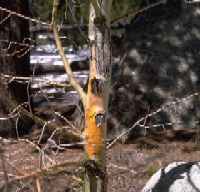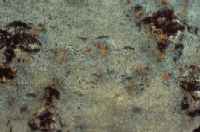by W.R. Jacobi* (12/13)
Quick Facts…

Figure 1: Orange discoloration found in spring and early summer associated with cytospora canker. |

Figure 2: Cytospora canker on three branches, each with scattered pycnidia. |

Figure 3: Orange spores oozing from pycnidia. |
- Cytospora canker is caused by several species of Cytospora (sexual form Valsa and Leucostoma) fungi. The name comes from the asexual stage of the pathogen that is more commonly seen.
- The disease occurs on woody shrubs and trees or parts of plants that are slightly stressed.
- Many trees and shrubs are affected by this disease (apple, ash, aspen, birch, cottonwood, elm, maple, peach, spruce, willow).
- The canker-causing fungi cause girdling of the plant, killing the plant above the canker.
- To manage the disease, reduce stress on trees, use resistant plants, remove infected limbs, clean wounds and prune properly.
Cytospora canker is caused by various species of the fungus Cytospora (sexual genera of Valsa and Leucostoma). These pathogens affect many species of shrubs and trees in Colorado, including aspen, cottonwood, lombardy and other poplars, apple, cherry, peach, plum, birch, willow, honeylocust, mountain ash, silver maple, spruce, and Siberian elm. Some Cytospora species are host-specific while other species can infect several different tree species. For example, willow, cottonwoods, and aspen are susceptible to one species. The fungus attacks trees or parts of trees that are injured or in a weak or stressed condition. The fungus grows in the living bark (phloem) and wood (xylem) and kills by girdling the branch or tree. The fungus can attack tree bark during the fall-winter spring seasons when temperatures are warm but the tree is dormant and cannot defend itself. Trees affected by drought, late spring frosts, insect and fungi defoliation, sunscald, herbicides, or mechanical injury are susceptible to Cytospora infection. The disease especially affects trees with root damage, which are often found in areas under construction, or trees that recently have been transplanted. Stands of aspen that have been thinned and young aspen sprout stands may suffer from Cytospora canker.
Sexual and asexual spores of Cytospora species infect freshly wounded tissue. The spores are released after fruiting bodies have absorbed water during rain events. Conidia ooze out of the wet fruiting bodies and are dispersed by rain splash and blown by wind. Many times fruiting bodies are not formed since the cankered tissue dries out too rapidly in the dry western climates.
Symptoms
Cytospora species cause branch dieback and cankers on trees or shrubs. Cankers on stems and branches are often elongate, slightly sunken, discolored areas in the bark. Many times, however, the discoloration is not evident because the fungus killed the bark rapidly. The fungus grows so fast on stressed trees that there is no evidence of a sunken canker. Bark often splits along the canker margin as the tree is defending itself and callus formation occurs. The fungus may quickly girdle and kill twigs without forming cankers. Symptoms vary with host species affected and stage of disease development. Bark above infected cambium may appear sunken and yellow, brown, reddish-brown, gray, or black. Diseased inner-bark and cambium turns reddish-brown to black, and becomes watery and odorous as it deteriorates. Wood below the cambium is stained brown (Figure 1). Liquid ooze on aspen and gummy ooze on peach and cherry are common. Cankers, sunken dead areas of bark with black pinhead-sized speckling or pimples, may be evident (Figure 2). The pimples are the reproductive structures of the fungus. Under moist conditions, masses of spores (seeds) may ooze out of the pimples in long, orange, coiled, thread-like spore tendrils (Figure 3). Reddish-brown discoloration of the wood and inner bark also may be evident. Dead bark may remain attached to the tree for several years, and then fall off in large pieces.
On spruce trees, the disease appears as sunken, resinous areas surrounded by swollen callus, giving a gall-like appearance. Small black fruiting bodies may occur on the canker. Once the branch is girdled, needles may yellow or redden. The branch eventually dies. Large amounts of resin flow from infected areas, coating branches and stems. Unless you see sunken areas surrounded by swollen callus, resin flow on spruce may indicate that other stresses, diseases or insects are affecting the tree.
Control
Because this canker disease usually occurs on a weakened host, the primary method of control is to prevent stress on the tree. Drought and oxygen starvation of roots by flooding soil with water are the two most common stresses that predispose trees to Cytospora infection. High temperatures seem to be related to Cytospora canker on our local alders.
To help a tree resist infection, prepare soil before planting, fertilize, water properly for winter and summer, prune, and avoid injury to the trunk and limbs. Proper care of recently transplanted trees also is essential to avoid stress and infection. See fact sheets 2.932, Environmental Disorders of Woody Plants, 7.211, Fall and Winter Watering, and GardenNotes 635, Care of Recently Planted Trees.
Wounds caused by lawnmowers and weed trimmers are prime targets for infection on trees in landscaped areas. Insects, such as oystershell scale, stress the tree and predispose it to Cytospora infection. Insects should be controlled to prevent mortality by the combined stress of the insects and Cytospora canker.
Help prevent cankers at pruning wounds on peach and cherry trees by applying labeled fungicides as wound dressings. Do not rely on the effectiveness of fungicides on wounds of other trees to prevent infection.
Another way to prevent Cytospora damage is to use species or varieties well adapted to the planting site conditions. These cultivars will be more likely able to resist the disease. Purchasing healthy nursery stock will decrease the possibility of infection. Once infection occurs, the best treatment is to increase plant vigor and sanitation. Remove all infected limbs and other areas. When removing branches, arborists and homeowners should make a smooth cut at the base of the limb, as near the trunk as possible, without damaging the branch collar (swollen area at base of branch). Jagged and rough cut surfaces promote infection. Once infection occurs, the best treatment is to increase plant vigor and sanitation. Remove all infected limbs and other areas. Clean wounds to avoid further spread of infection. Remove dead bark to dry out the diseased area and help the tree defend itself against insect and fungal attacks on the cankered area. Directions for proper wound and canker treatment are as follows:
- Prune or cut trees only during dry weather.
- Clean tools and wipe them with ethyl alcohol, Lysol or other disinfectant. Clorox may be used at a concentration of one part Clorox to nine parts water.
- If a wound is fresh (one month old or less), use a sharp knife to carefully cut and remove all injured or diseased bark back to live, healthy tissue. If the wound is older, just remove loose bark pieces. It is important not to cut, remove or damage callus that may be forming at the canker edge. Callus will look like swollen bark growing across the dead area. Scrape the wound surface clean of loose bark.
- Clean tools and disinfect after each cut.
- Cleaned wounds should not have any sharp angles.
- Do not apply any tar, oil-based paint or other wound dressing. The best method to prevent infection or decay is to allow the cleaned tissue to dry out.
| Table 1: Some resistant species and cultivars. | |
| Ash | Most cultivars. |
| Aspen | Resistant cultivars not commercially available. |
| Cottonwood | Cultivars: Noreaster, Platte, Mighty Mo, Ohio Red. Avoid Lombardy, Bolleana, Sioux Land. |
| Elms | Most cultivars |
| Hackberry | Most cultivars |
| Honeylocust | Most cultivars. |
| Junipers | Most cultivars. |
| Lindens | Big and little leaf. |
| Maples | Most species and cultivars. |
| Pines | Most species and cultivars. |
1Colorado State University professor, bioagricultural sciences and pest management. 9/99. Revised 12/13.
Colorado State University, U.S. Department of Agriculture and Colorado counties cooperating. Extension programs are available to all without discrimination. No endorsement of products mentioned is intended nor is criticism implied of products not mentioned.
Go to top of this page.





